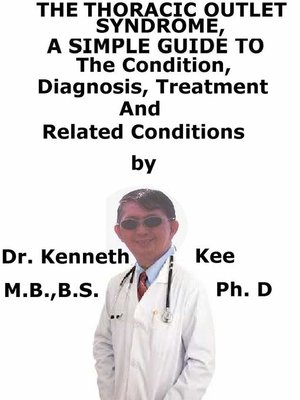The Thoracic Outlet Syndrome, a Simple Guide to the Condition, Diagnosis, Treatment and Related Conditions
ebook
By Kenneth Kee

Sign up to save your library
With an OverDrive account, you can save your favorite libraries for at-a-glance information about availability. Find out more about OverDrive accounts.
Find this title in Libby, the library reading app by OverDrive.



Search for a digital library with this title
Title found at these libraries:
| Library Name | Distance |
|---|---|
| Loading... |
This book describes The Thoracic Outlet Syndrome, Diagnosis and Treatment and Related Diseases
Thoracic outlet syndrome (TOS) is a complex medical disorder featured by different neurovascular signs and symptoms of the upper limb due to injury in the cervicothoracobrachial region.
"Thoracic outlet syndrome (TOS)" is the term applied to depict a group of disorders that happen when there is compression, injury, or irritation of the nerves and blood vessels (arteries and veins) in the lower neck and upper chest area as they exit through the thoracic outlet.
TOS is an umbrella term that comprises 3 related syndromes that involve compression of the nerves, arteries, and veins in the thoracic outlet and cause pain in the arm, shoulder, and neck.
There are 3 types of thoracic outlet syndrome:
1. Neurogenic: Affects nerves leading from the spinal cord to the neck to the arm.
Majority of thoracic outlet syndrome cases involve nerves.
2. Venous: Affects veins
3. Arterial: Affects arteries
About 95% of thoracic outlet syndrome cases affect the brachial nerves.
It is infrequent but more serious when it involves a vein or an artery.
It is 3-4 times as frequent in woman as in men between the age of 20 and 50 years.
Females have a lesser amount of developed muscles, a higher likelihood for drooping shoulders due to extra breast tissue, a narrowed thoracic outlet and a structural lower sternum
These factors alter the angle between the scalene muscles and consequently cause a higher incidence in women.
There are many causes of thoracic outlet syndrome such as physical trauma, structural defects, tumors that compress nerves, poor posture that induces nerve compression, pregnancy, and repetitive arm and shoulder movements and activity, such as from playing certain sports.
The symptoms are:
1. Pain in the neck, shoulder, or arm
2. Numbness and tingling
3. Swelling
4. Weakness
5. Discoloration — blue, red, or pale
6. Cold hands
The TOS related disorders are:
1. Carpal tunnel syndrome
2. Peripheral neuropathies (like ulnar nerve entrapment at the elbow, shoulder tendinitis and impingement syndrome)
3. Fibromyalgia of the shoulder and neck muscles
4. Cervical disc disease (like cervical spondylosis and herniated cervical disk)
The diagnosis of TOS is essentially based on the medical history, physical examination, provocative tests, and ultrasound, radiological evaluation and electrodiagnostic evaluation.
The disorder can occasionally be diagnosed in a physical examination by tenderness in the supra-clavicular area, weakness and a "pins and needles" sensation when raising the hands, weakness in the fifth finger, and paleness in the palm of one or both hands when the person raises them above the shoulders, with the fingers pointing to the ceiling.
Doctors normally advise nerve conduction studies, electromyography, or imaging studies to confirm or exclude a diagnosis of TOS.
The treatment starts with exercise programs and the physical therapy to strengthen chest muscles, restore normal posture, and alleviate compression by raising the space of the area the nerve passes through.
Doctors will often give non-steroidal anti-inflammatory drugs (naproxen or ibuprofen) for pain.
Other medicines are thromobolytics to break up blood clots and anticoagulants to stop clots.
If this does not relieve pain, a doctor may advise thoracic outlet decompression surgery to release or eliminate the structures causing compression of the nerve or artery.
Thrombolytic medicines are given to dissolve blood clots before...







